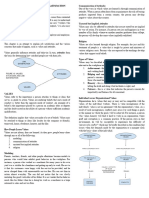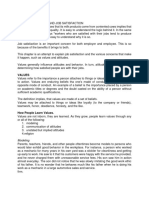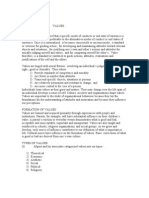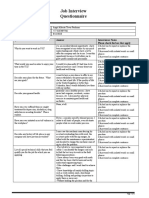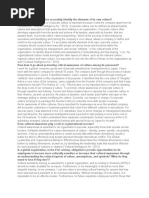Module 4
Module 4
Uploaded by
Kevin Von AnchetaCopyright:
Available Formats
Module 4
Module 4
Uploaded by
Kevin Von AnchetaOriginal Title
Copyright
Available Formats
Share this document
Did you find this document useful?
Is this content inappropriate?
Copyright:
Available Formats
Module 4
Module 4
Uploaded by
Kevin Von AnchetaCopyright:
Available Formats
Bachelor of Science in Indusrial Technology
MODULE 4
VALUES, ATTITUDES, AND
JOB SATISFACTION
Introduction
This chapter is explains job satisfaction and the various concerns that make it happen,
such as values and attitudes. It also discusses the ways on how employees satisfied their job,
values formation and importance of attitudes towards work.
Learning Outcome
Discuss the meaning of values, attitudes and job satisfaction
Differentiate values and attitudes
Identify the factors in learning values
Discuss the components and importance of Attitudes
Understand how attitudes are formed
Analyze the effect of attitude in employee
Identify and explain the different factors in satisfying job
Discuss the meaning of motivation
Determine the different theories in motivation
a. Values
b. Types of Values
c. Attitudes
d. Job Satisfaction
e. Job Involvement
A. Values
Refers to the importance a person attaches to things or ideas that serves as guide to
action. Values are enduring belief that one’s mode of conduct is better than the opposite mode
of conduct.
An example of a belief is the importance placed by a person on academic titles or
degrees and the doubt casted on the ability of a person without sufficient academic qualification.
Human Behavior in Organization Page 1
Bachelor of Science in Indusrial Technology
The definition implies that values are made of a set of beliefs. Values may be attached to
thing or ideas like loyalty (to the company or friends), teamwork, honor, obedience, honesty,
and the like.
How People Learned Values
Values are not inborn, they are learned. As they grow, people learn values through any
or all of the following:
1. modeling
2. communication of attitudes
3. unstated but implied attitudes
4. religion
Modeling
Parents, teachers, friends, and other people oftentimes become models to persons who
would later exhibit good behavior in the workplace. For instance, a person who worked as a
mechanic for many years in his own yard was stickler for cleanliness and getting up early to
work. He saw to it that his costumers were happy with the services fee. His son saw him in
almost every day.
Communication of Attitudes
One of the ways in which values are learned is through communication of attitudes.
When a person often hears form acquaintance the risk of buying product imported from a
certain country, the person may develop negative values about that country.
Unstated but Implied Attitudes
Values may also be affected by attitudes that are not stated but are implied by way of
action.
For instances, if a person sees joy and happiness in every member of his family whenever
another member graduates from college, the person will develop the same values impliedly
exhibited.
Religion
Values are also learned through religion.
For example, the just and fair treatment of people is a value that is taught by priest and minister
of various religious sects. Person who are exposed to the teachings develop values that support
such belief.
B. Types of Values
Values are also be classified in various ways. A classification that is most relevant to the
workplace indicates that values are of the following types:
1. Achievement- this is a value that pertains to getting things done and working hard to
accomplish goals;
2. Helping and concern for others- this value refers to the person’s concern with other
people and providing assistance to those who need help;
3. Honesty- this is a value that indicates the person’s concern for telling the truth and
doing what he thinks is right.
Human Behavior in Organization Page 2
Bachelor of Science in Indusrial Technology
4. Fairness- this is a value that indicates the person’s concern for impartiality and
fairness for all concerned.
Individuals versus Organizational Values
Organizations have values that may or may not be compatible with the values of the
individual worker. There is value incongruence if the individual’s value is not in agreement with
the organization’s value.
As a result of such incongruence, conflicts may arise over such things as goals or the manner
in which the goals will be achieved.
For instance, a person who values honesty will find it hard to work in an organization
where graft and corruption is a common practice.
If the person stays in that environment, he will be susceptible to experience the difficulty
of “person-role conflict” which may be briefly described as the condition that occurs when the
demands made by the organization or a manager clash with basic values of the individual.
Espoused versus enacted values
What the company promotes as its own values may be different from what is practiced by
the organization’s individual members.
Values may be classified as either
1. Espoused
2. Enacted values
Espoused values
Are what members of the organization say they value. A business organization, for
instance, may state that it highly values its good relationship with customers. However, if the
employees of the said company give priority to calls from relatives and friends rather than
responding immediately to customer’s inquiries, they are not actually practicing the values
espoused by the company. Those that are reflected in the actual behavior of the individual
members of the organization are referred to as enacted values.
Instrumental and Terminal values
Another classification of values may be presented as;
1. Terminal values
2. Instrumental values
Terminal Values- represent the goals that a person would like to achieve in his or her lifetime.
Example: happiness, love, pleasure, self-respect, and freedom.
Instrumental Values- refer to preferable modes of behavior or means of achieving the terminal
values.
Example: ambition, honesty, self-sufficiency, and courageousness
Human Behavior in Organization Page 3
Bachelor of Science in Indusrial Technology
INSTRUMENT TERMINAL
AL VALUES VALUES
Ambition Happiness
Honesty Pleasure
Self-Sufficiency Self-Respect
Courage Freedom
Forgiving Nature World Peace
Helpfulness Equality
Self-Control Achievement
Independence Inner Peace
Obedience Beauty In Art And Nature
Open-Mindedness Family Security
Cleanliness Salvation
Afffection Friendship
Politeness Mature Love
Rationality Wisdom
Responsibility Prosperity
Competence National Security
Cheerfulness Social Respect
Intelligence Exciting
Imagination Active Life
C. Attitudes
Attitudes are important in the study of human behavior. This is so because they are
linked with perception, learning, emotions, and motivation. Attitudes also form the basis for job
satisfaction in the workplace. Attitudes are feelings and beliefs that largely determine how
employees will perceive their environment, commit themselves to intended actions, and
ultimately behave. Attitudes Reflect how one feels about something. For instance, a person may
think working overtime is necessary if the situation requires it, or may consider work as an
important ingredient of one’s physical and mental well-being.
THE MAIN COMPONENTS OF ATTITUDES
1. Cognitive
2. Affective
3. Behavioral
1. Cognitive Component
Human Behavior in Organization Page 4
Bachelor of Science in Indusrial Technology
-Refers to the opinion or belief segment of an attitude.
Ex; “my boss is fickle-minded; he cannot stick to his decision.”
2. Affective Component
-Refers to the emotional or feeling segment. The bad feeling.
Ex; “I hate my boss”
3. Behavioral Component
-Refers to the intention to behave in a certain way toward someone or something.
Ex; “I have requested a transfer to another department from my superiors.”
Differences in Personal Disposition
People differ in their personal disposition. Some have attitudes that are POSITIVELY
AFFECTIVE, while some have NEGATIVELY AFFECTIVE attitudes.
Positive Affectivity – Refers to personal characteristic of employees that inclines them
to be predisposed to be satisfied at work. People who have positive affectivity are optimistic,
upbeat, cheerful, and courteous.
Negative Affectivity- Is a personal characteristic of employees that inclines them to be
predisposed to be dissatisfied at work. People who have negative affectivity are generally
pessimistic, downbeat, irritable, and sometimes, abrasive.
Managers and supervisors will benefit from knowing the personal disposition of their
subordinates. Their decisions regarding training, hiring, and promotion could be made better.
How Attitudes Are Formed
Attitudes are formed through learning. The two methods that mostly influence attitude
formation are direct experience and indirect means of social learning. Among the information
stored in the human mind, those that were gathered through direct experience are the most
accessible. So if one had an unpleasant experience with another person, his attitude regarding
that person would be negative regardless of any other information obtained from indirect means.
Although indirect means affect the formation of attitudes, their influence is not as strong as
direct experience.
Attitudes that are formed in an indirect way are the result of social interactions with the
family, peer groups, religious organizations, and culture. For instance, if parents behave in a
manner showing disdain towards smokers, the children will have a strong tendency to adapt an
attitude of indifference towards smokers.
Most Important Attitudes in the Workplace
Work behavior is of utmost importance to managers and superiors. Since work attitudes affect
work behavior, the requisite concerns are focused on them.
The most important attitudes in the workplace are:
1. Job satisfaction
2. Job involvement; and
3. Organizational commitment.
Effects of Employee Attitudes
Human Behavior in Organization Page 5
Bachelor of Science in Indusrial Technology
Attitudes provide clues to the behavioral intentions or inclinations of an employee. The
manner in which a person will act can be gleaned from his attitudes.
Employee attitudes may be classified as either:
1. Positive job attitudes; or
2. Negative job attitudes
Positive Job Attitudes- indicate job satisfaction and are used in predicting constructive
behaviors like serving customers beyond official working hours, and performing excellently in all
aspects of their jobs. An example of positive job attitudes is “I enjoy wearing my office uniform”.
Negative Job attitudes - are also useful in predicting undesirable behavior. Negative
job attitudes include those concerning job dissatisfaction, lack of job involvement, low
commitment to the organization, and strong negative words like “the office assigned to me does
not speak well of my position”.
When employees are dissatisfied with their jobs, they will have a strong tendency to engage in
any or all of the following:
1. Psychological withdrawal like daydreaming on the job;
2. Physical withdrawal like unauthorized absences, early departures, extended breaks, or work
slowdowns; and
3. Aggression, like verbal abuse or dangerous actions against another employee.
Making Positive Attitudes Work for the Organization
People with positive work attitudes make it easy for the organization to achieve its
objectives. As such, recruitment officers must require positive work attitudes before employment
offers are made. Those who are already employed by the organization but whose attitudes are
negative must be made to participate or become beneficiaries of programs designed to change
negative work attitudes of employees to positive work attitudes
In the process of recruiting people to fill the various job vacancies in the organization,
proven methods of selection must be made. Applicants found to have positive work attitudes
should be considered for hiring in other job requirements are met.
There are various ways of changing employee attitudes. One is making the reward
system closely tied to individual or team performance
D. Job Satisfaction
The attitude people have about their jobs is called job satisfaction. In a strict sense,
however, job satisfaction refers to the positive feeling about one’s job resulting from an
evaluation of its characteristics. When the feeling about one’s job is not positive, the appropriate
term is job dissatisfaction.
When people are satisfied with their jobs, the fallowing benefits become possible:
1. High productivity
2. A stronger tendency to achieve customer loyalty
3. Loyalty to the company
4. Low absenteeism and turnover
5. Less job stress and burnout
6. Better safety performance
7. Better life satisfaction
Factors Associated With Job Satisfaction
Human Behavior in Organization Page 6
Bachelor of Science in Indusrial Technology
1. Salary- adequacy of salary and perceived equity compared with others.
2. Work it- the extent to which job tasks are considered interesting and provide
opportunities for learning and accepting responsibility.
3. Promotion opportunity- chances for further advancement.
4. Quality of supervision- the technical competence and the interpersonal skills of one’s i
5. Relationship with co-workers- the extent to which co-workers are friendly, competent,
and supportive.
6. Working conditions- the extent to which the physical work environment is comfortable
and supportive of productivity.
7. Job security- the beliefs that one’s position is relatively secure and continued
employment with the organization is a reasonable expectation.
Ways of Measuring Job Satisfaction
1.The single global rating method refers to that approach where individuals are asked to
respond to a single question, such as, “how satisfied are you with your job?” the respondents
indicate there answers by putting a check() before any of the numbers from 5 to 1 as indicated
below:
_______1.highly satisfied
_______2.moderately satisfied
_______3.indifferent
_______4.moderately dissatisfied
_______5.highly dissatisfied
2. The summation score method.
-is an approach where individuals indicate their feelings regarding each key factors of
their job. The factors would normally consist of the work, supervision, current, salary, promotion
opportunities, and relations with co-workers. A standard scale is used to rate the factors and
then the overall job satisfaction score is derived.
A Sample Questionnaire For The Summation Score Method Of Job Satisfaction
Please indicate on the blanks provided below how satisfied you are (in terms of
percentage) in each of the following factors of your job;
_______% 1.work itself
_______% 2.salary (or pay)
_______% 3.promotion opportunities
_______% 4.supervision
_______% 5.co-workers
Note: To be filled by the enumerator:
____% Overall percentage score
E. Job Involvement
Job involvement is another positive employee attitude. It refers to the degree to which a
person identifies with the job, actively participates in it, and considers performance important to
self-worth. People who are really “involved” in their jobs view work as a central part of their
overall lives.
A positive self-image is a result of a person’s holding a meaningful job and actively
performing it.
People with a high degree of job involvement will seldom be late or absent. They are
willing to work long hours if necessary, and they will strive to be high performers.
Human Behavior in Organization Page 7
Bachelor of Science in Indusrial Technology
Organizational Commitment
Organizational commitment is the third positive employee attitude. It refers to the degree
to which an employee identifies with a particular organization and its goals and wishes to
maintain membership in the organization.
Organizational commitment often reflects the employee’s belief in the mission and goals
of the organization, willingness to expend effort in accomplishing them, and intentions to
continue working in the organization. Employees who are organizationally committed have good
attendance records, show willingness to adhere to the firm’s policies, and lower turnover rates.
OC May Be Categorized Into Three Dimensions.
1. Affective commitment.
2. Continuance commitment.
3. Normative commitment.
Affective commitment- refers to the employee’s emotional attachment to the
organization and belief in its values.
Continuance commitment- refers to the employee’s tendency to remain in an
organization because he cannot afford to leave. In fact many employees continue to be
committed to the firm because they feel they could not get better employment elsewhere. The
reason why the employees choose to continue employment with the firm may be classified as
either (1) Economic; or non-economic. Economic factors refer to salary, allowances, and
retirement pension. (2) Non-economic- benefits include participation in decision making, job
security, and certain job characteristics such as autonomy, responsibility, and interesting work.
Normative commitment- refers to an obligation to remain with the company for moral or
ethical reason. For example, an employee working in zoo May remain with his employer
because he feels most of the animals under his care would respond only to him and it would be
hard to find a suitable replacement for him. He thinks that the existence of the zoo would be in
jeopardy if he leaves
Summary
Values, attitudes and job satisfactions are important concerns for managers and
employees. When employees are satisfied with the work they do, it is expected that their work
performance would be highly satisfactory.
Job satisfaction, however, is possible if the employees possess the right value and
attitudes.
Values are guidelines and beliefs that persons uses when confronted with situation in
which a choice should be made.
Attitudes are feelings and beliefs that largely determine how employees will perceive
their environment, commit themselves to intended actions, and ultimate behavior.
Values may be learned through modeling, communication of attitudes, unstated but
implied attitudes and religion.
Values may be classified as: (1) achievement (2) Helping and concern for other (3)
honesty and (4) fairness.
The person’s values are different from organizational values. They may be compatible or
not.
Values may also be classified as espoused (or what member the member of the
organization values) or enacted (those reflected in the actual behavior of employee)
Values may also be terminal (those who representing the goals that a person would like
to achieve in his lifetime) or instrumental (those that are used in achieving the terminal values).
Human Behavior in Organization Page 8
Bachelor of Science in Indusrial Technology
Attitudes reflects how one feels about something. They consist of cognitive, affective,
and behavioral components.
The most important attitudes in the workplace are those concerning job satisfaction, job
involvement, and organizational commitment.
Additional readings/ video information
Attitude, Perception, Values video links
https://www.youtube.com/watch?v=u5eY6v2fVbY
Online (synchronous)
Google classroom
Facebook group
Messenger
Zoom
Google meet
Remote (asynchronous)
Module
Exercises
REFERENCES
Book:
Medina, R. 2011. Human Behavior In Organization Copyright by Rex Book Store, Inc.
Internet sources:
https://www.youtube.com/watch?v=u5eY6v2fVbY
Prepared by:
MA. THERESA R. RESPICIO
Instructor
Human Behavior in Organization Page 9
You might also like
- 2022 2023 School Counselors HandbookDocument132 pages2022 2023 School Counselors HandbookCraig MongerNo ratings yet
- Psychological Well-Being BookDocument210 pagesPsychological Well-Being Book2robertodomi100% (3)
- Chapter 4 HboDocument13 pagesChapter 4 HboJenNo ratings yet
- Chapter 4Document62 pagesChapter 4Kwini CBNo ratings yet
- Personality and Values: Presented By: Shireen Sahira Sp09-Mb-0132 Uzma SumairaDocument34 pagesPersonality and Values: Presented By: Shireen Sahira Sp09-Mb-0132 Uzma SumairasahirabhagatNo ratings yet
- The Work PlaceDocument12 pagesThe Work Placelisette omayanaNo ratings yet
- Hb0chap4 6Document13 pagesHb0chap4 6Cris TineNo ratings yet
- L4 HboDocument4 pagesL4 HboShenelle DatinggalingNo ratings yet
- HBO Lesson 4 - Values, Attitude, and Job SatisfactionDocument9 pagesHBO Lesson 4 - Values, Attitude, and Job SatisfactionJoe P PokaranNo ratings yet
- MNGT. 6 MODULE 4 MIDS-mergedDocument15 pagesMNGT. 6 MODULE 4 MIDS-mergedRyan Prado AndayaNo ratings yet
- Values DevelopmentDocument27 pagesValues DevelopmentJohn Paulo AlejoNo ratings yet
- Chapter 4: Values, Attitudes, and Job SatisfactionDocument10 pagesChapter 4: Values, Attitudes, and Job SatisfactionShy CabuenasNo ratings yet
- Values, Attitudes, and Job Satisfaction: Learning ObjectivesDocument5 pagesValues, Attitudes, and Job Satisfaction: Learning ObjectivesPrince Calica100% (1)
- Lesson 4: Values, Attitude & Job Satisfaction: How People Learn ValuesDocument2 pagesLesson 4: Values, Attitude & Job Satisfaction: How People Learn ValuesMarkNo ratings yet
- Psychology 1Document4 pagesPsychology 1adil khanNo ratings yet
- Values, Attitude Perception & Personality: Dr. A. HansDocument66 pagesValues, Attitude Perception & Personality: Dr. A. HansMrhunt394 YTNo ratings yet
- HBO Chap4Document9 pagesHBO Chap4Art Tumakay RabinoNo ratings yet
- Attitudes, Values, and EthicsDocument20 pagesAttitudes, Values, and EthicsAnchal JainNo ratings yet
- Moral Values and Character Development CF OriginalDocument52 pagesMoral Values and Character Development CF OriginalMaria Christine OlanNo ratings yet
- MODULE 3 - Human Behavior in OrganizationsDocument51 pagesMODULE 3 - Human Behavior in OrganizationsRACHEL NAVARRO100% (1)
- Module 4 DraftDocument16 pagesModule 4 DraftAngel Mae CristobalNo ratings yet
- Values, Attitudes and Job Satisfaction ValuesDocument9 pagesValues, Attitudes and Job Satisfaction Valuesjoienica buenoNo ratings yet
- Answer_Writing_Analysis_of_Interpersonal_Relations_10f43cceb7834fc0a03f70a3c8611de0_lyst1715231143430Document18 pagesAnswer_Writing_Analysis_of_Interpersonal_Relations_10f43cceb7834fc0a03f70a3c8611de0_lyst1715231143430Mayank GuptaNo ratings yet
- NSTP CWTS Lk2-NotesDocument4 pagesNSTP CWTS Lk2-NotesLieu Hiel MalabasNo ratings yet
- Be 2Document5 pagesBe 2aamarnaths2021No ratings yet
- ValuesDocument29 pagesValuesManmohan sharmaNo ratings yet
- HBO Module Midterm and FinalsDocument24 pagesHBO Module Midterm and FinalsMariane Joyce R. BolesaNo ratings yet
- Human Person and Values DevelopmentDocument11 pagesHuman Person and Values DevelopmentREIANA MITZI M. FernandezNo ratings yet
- The Importance of ValuesDocument7 pagesThe Importance of ValuesAmaru ErskineNo ratings yet
- Chapter-3 IBTDocument31 pagesChapter-3 IBTcarolinesweet250No ratings yet
- Corporate Social ResponsibilityDocument19 pagesCorporate Social ResponsibilityMonika SharmaNo ratings yet
- Unit - 2: Foundation of Individual Behavior A) Attitude B) Values C) PersonalityDocument34 pagesUnit - 2: Foundation of Individual Behavior A) Attitude B) Values C) PersonalityKunal GuptaNo ratings yet
- VALUES INTRODUCTION: Value Is An Enduring Belief That A SpecificDocument15 pagesVALUES INTRODUCTION: Value Is An Enduring Belief That A Specificpulmonga100% (1)
- Human Behavior Reviewer (3RD Year, Midterm, 1ST Sem)Document13 pagesHuman Behavior Reviewer (3RD Year, Midterm, 1ST Sem)ronelynNo ratings yet
- Unit 2OB – Module 2Document60 pagesUnit 2OB – Module 2kevalkannu27No ratings yet
- Notes On Unit 4 OBSDocument3 pagesNotes On Unit 4 OBSAlessia GaleottiNo ratings yet
- PD and L - Unit 1Document47 pagesPD and L - Unit 1priyankadiniz10No ratings yet
- Organizational Behavior: Dr. Kashif MEHMOODDocument19 pagesOrganizational Behavior: Dr. Kashif MEHMOODZaryab KhanNo ratings yet
- Difference Between Values and AttitudesDocument4 pagesDifference Between Values and AttitudesRhea SaguidNo ratings yet
- PEHV unit1Document87 pagesPEHV unit1Shruti NarangNo ratings yet
- Reporter: Kenny Mark C. Fresco Topic: The Organization's Culture and Values Date: August 3, 2019 Professor: Dr. Eddie E. Llamedo PrayerDocument6 pagesReporter: Kenny Mark C. Fresco Topic: The Organization's Culture and Values Date: August 3, 2019 Professor: Dr. Eddie E. Llamedo PrayerKenny Mark FrescoNo ratings yet
- Attitudes, Values, and EthicsDocument20 pagesAttitudes, Values, and EthicsPiyush_Ranjan__6414No ratings yet
- Human Behavior in Organization: Importance Goals Nature of PeopleDocument178 pagesHuman Behavior in Organization: Importance Goals Nature of PeopleLevirolfDeJesusNo ratings yet
- I. Values Development: A. Value DefinedDocument9 pagesI. Values Development: A. Value DefinedJohn MarcNo ratings yet
- Values: I. What Are The Values in Life?Document54 pagesValues: I. What Are The Values in Life?Mildred TañolaNo ratings yet
- PEHVDocument87 pagesPEHVitsaartihere001No ratings yet
- Values, Attitude and Job SatisfactionDocument6 pagesValues, Attitude and Job SatisfactionChino Pacia100% (1)
- Hbo ValuesDocument4 pagesHbo Valuespirits11No ratings yet
- Authentic Leadership QuetionnaireDocument34 pagesAuthentic Leadership QuetionnaireHesti Daryadi100% (1)
- OBDocument2 pagesOBKashish BenawatNo ratings yet
- Ob Presentation (C)Document23 pagesOb Presentation (C)Arslan AshrafNo ratings yet
- CHAPTER 3 (Attitude, ValuesDocument20 pagesCHAPTER 3 (Attitude, ValuesManpreet kaurNo ratings yet
- Monteron, Genevieve M. B119Document5 pagesMonteron, Genevieve M. B119Genevieve MonteronNo ratings yet
- OB Mid-TermDocument11 pagesOB Mid-TermJoy NathNo ratings yet
- Moral Values & Character BuildingDocument52 pagesMoral Values & Character BuildingmshamirmNo ratings yet
- Personality Development Unit-3, 4 NotesDocument67 pagesPersonality Development Unit-3, 4 NotesAdarshNo ratings yet
- White Illustrative Creative Literature Project Presentation 1Document19 pagesWhite Illustrative Creative Literature Project Presentation 1atienzacondescNo ratings yet
- Personality & ValueDocument25 pagesPersonality & ValueDeepayan CNo ratings yet
- Discussions and ReviewsDocument8 pagesDiscussions and ReviewsRose John SupranesNo ratings yet
- Mi Lec. 6Document7 pagesMi Lec. 6boombasticmr134No ratings yet
- Smart Looks and Sharp Minds: Crafting an Extraordinary SelfFrom EverandSmart Looks and Sharp Minds: Crafting an Extraordinary SelfNo ratings yet
- Template For Lesson Plan: Number 9 Amra Jasem 5/11/2018 9:30 AM (15MIN) Taryam American Private School - KG2Document3 pagesTemplate For Lesson Plan: Number 9 Amra Jasem 5/11/2018 9:30 AM (15MIN) Taryam American Private School - KG2api-393643685No ratings yet
- Literature Review On Family ViolenceDocument10 pagesLiterature Review On Family Violencec5qp53ee100% (1)
- FLY ADEPT 15 Essential Skills Report US 7243 Web PDFDocument2 pagesFLY ADEPT 15 Essential Skills Report US 7243 Web PDFUtkarsh SrivastavaNo ratings yet
- Modifiers of Human Acts PDFDocument32 pagesModifiers of Human Acts PDFmatt gerard perez50% (2)
- Life ChallengesDocument28 pagesLife Challengesngavi4543No ratings yet
- Thesis For RoutingDocument75 pagesThesis For RoutingErnesto Soriano BasingaNo ratings yet
- Theory of Nursing As CaringDocument6 pagesTheory of Nursing As CaringKim BadillesNo ratings yet
- Sleep Mastery 730PM - Workshop ManualDocument7 pagesSleep Mastery 730PM - Workshop ManualAkash VermaNo ratings yet
- Metrics: View Original From Jurnal - Unai.eduDocument1 pageMetrics: View Original From Jurnal - Unai.eduwitria grifaniNo ratings yet
- Strategy ProcessDocument24 pagesStrategy Processananto muhammadNo ratings yet
- Why Lord of The Flies Speaks Volumes About BoysDocument2 pagesWhy Lord of The Flies Speaks Volumes About Boysapi-308070012No ratings yet
- SBM Principles Indicators PDFDocument17 pagesSBM Principles Indicators PDFNelsBel86% (7)
- Employability SkillsDocument8 pagesEmployability SkillsHerman TyagiNo ratings yet
- Grade 7 Homeroom Guidance BolinasDocument27 pagesGrade 7 Homeroom Guidance Bolinasariane galenoNo ratings yet
- Models For Structuring Reflection: Leeds Beckett UniversityDocument7 pagesModels For Structuring Reflection: Leeds Beckett Universityanh điệp nguyễnNo ratings yet
- Story of Baristas: Cognitive ComponentsDocument5 pagesStory of Baristas: Cognitive ComponentsUmair NadeemNo ratings yet
- Interviews About Culture Shocks TypesDocument22 pagesInterviews About Culture Shocks Typesapi-9291491No ratings yet
- Job Interview QuestionnaireDocument6 pagesJob Interview QuestionnairePOOL SERVICES & SUPLLIES100% (1)
- Story of One Minute ManagerDocument48 pagesStory of One Minute ManagerImran Malik100% (6)
- How Does An Organization Accurately Identify The Elements of Its Own CultureDocument2 pagesHow Does An Organization Accurately Identify The Elements of Its Own CultureDjahan Rana100% (5)
- Basic Needs (Hunger, Thirst, Sleep)Document3 pagesBasic Needs (Hunger, Thirst, Sleep)bidife1271No ratings yet
- Theory of Health As Expanding ConsciousnessDocument20 pagesTheory of Health As Expanding ConsciousnessDONALDNo ratings yet
- Muscle Dysmorphia Disorder: (MDD or Vigorexy)Document4 pagesMuscle Dysmorphia Disorder: (MDD or Vigorexy)Kate20No ratings yet
- Heredity and Environment in Intelligence ExpressionDocument3 pagesHeredity and Environment in Intelligence ExpressionAssignmentLab.comNo ratings yet
- C 4 ArtifactDocument7 pagesC 4 Artifactapi-338277899No ratings yet
- Human BehaviorDocument104 pagesHuman Behaviorkarl luis100% (1)
- L5M1 Session 2.1Document79 pagesL5M1 Session 2.1boldmeritacademy100% (2)
- Myers-Briggs Type Indicator (MBTI) : OriginDocument4 pagesMyers-Briggs Type Indicator (MBTI) : OriginSahil MushafNo ratings yet







